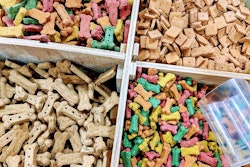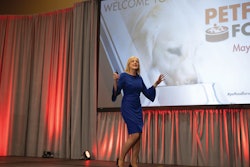
The successful implementation of automation can increase the efficiency, quality and safety in a pet food manufacturing environment, says Dean Elkins, senior director of robotics and vision at Gray Solutions. The use of robots, vision systems and autonomous mobile robots (AMRs) has never been easier to implement, operate and maintain.
The pet food industry faces higher demands for throughput, quality and adaptability, compounded by labor shortages and the necessity to meet flexible consumer demands effectively. Automation is the perfect way to augment the needs of the manufacturer to meet this changing demand, said Elkins.
“With throughput and quality demands on the rise, and labor availability not always in abundance, manufacturers are turning to flexible automation to realize gains,” he said.
Automation examples include data harvesting related to batching and blending; OEE data (the percentage of planned production that is truly productive); the timely delivery of raw and packaging materials to work areas; employing vision systems in optical character recognition; robotic testing; and automated case packing and palletizing.
Gray Solutions provides automation solutions to manufacturers that often include robots, autonomous vehicles, vision solutions, computer modeling and high-level controls. On April 30, Elkins will speak at Petfood Forum. His session, From kibble to bytes: Automating pet food quality control, will highlight various types of automation solutions and their benefits to the pet food processing space.
See Spot streamline quality control processes
During the presentation, Elkins will offer case studies and real-world applications, including how leading pet food manufacturers have leveraged automation, vision systems and robotics to improve their quality control processes.
As the pet food industry continues to evolve, leveraging this advanced technology will be indispensable to ensure quality and safety. Cutting-edge solutions, like Boston Dynamics' robot dog Spot, will not only save time and money, but keep employees safe.
Nestlé Purina recently deployed Spot to automate thermal and acoustic inspections in its packaging lines. Autonomous inspections allow them to give time back to the maintenance technicians, better predict and plan repairs, and ensure reliable operations.
“Robots like Spot can be deployed on autonomous missions to fetch samples as a part of quality evaluations,” said Elkins. “Other uses might be missions involving the detection of airflow or leaks in a temperature-controlled area or the reading of gauges across the factory.”
Scott Smith, maintenance electrician with Nestlé Purina Petcare, said Spot has freed up manpower for the pet food processor and allowed maintenance to catch issues before they become big problems. “If Spot can find these issues for us in between our changeovers in between different production runs, we’re able to catch those issues ahead of time that allows us to be more predictive, more preventative rather than reactive,” said Smith.
Spot also goes where most humans cannot. “We’re able to put Spot into situations where things are a little bit tighter, and that relieves a lot of bending, a lot of movements, and a lot of strain on the human body,” said Smith.
Getting started
Finding a good partner is the first step for a pet food processor when automating its operation. “It's very important to work with a trusted advisor to understand what is possible,” said Elkins. “This can be accomplished through the performance of plant automation audits and a bit of self-research.”
Automation tools are only increasing and understanding how to use this technology will help future-proof your pet food manufacturing facility. Future trends, such as programming and data harvesting coupled with AI, are allowing for greater automation power is shorter periods of time. Shorter project implementation, ramp- up and training periods can have a positive effect on throughput and ROI, said Elkins.
“Tangible benefits of automated quality checks include improved product consistency, lower error rates and enhanced compliance with industry standards and regulations,” he said.
“Automation has come a long way in flexibility and ease of use,” Elkins continued. “The manufacturer must invest in a culture that is complementary to automation. This goes beyond the plant layout and the product.
“Successful automation adopters understand the need for training of associates and proper preventative maintenance protocols to keep their automation investments running in a problem-free way,” he concluded.
Dean Elkins will speak at Petfood Forum on Tuesday, April 30, in Kansas City. His session, From kibble to bytes: Automating pet food quality control, will highlight various types of automation solutions and their benefits to the pet food processing space. For more information, visit petfoodforumevents.com.

















